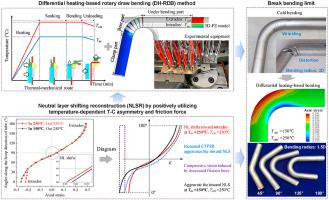International Journal of Machine Tools and Manufacture ( IF 14.0 ) Pub Date : 2021-05-07 , DOI: 10.1016/j.ijmachtools.2021.103742 Heng Yang , Heng Li , Jun Ma , Guangjun Li , Dan Huang

|
Achieving small-radius bending of difficult-to-form tubular materials with large-diameter, thin-walled (LDTW, D/t > 20) geometry — as well as the properties of high-strength poor-hardening (HSPH) — is a continual target and challenging issue in the aerospace, marine, and healthcare industries. Based on the theoretical analysis of neutral layer shifting reconstruction (NLSR) by positively utilizing the temperature-dependent tension-compression (T-C) asymmetry of tubes, an innovative differential heating-based rotary draw bending (DH-RDB) method is designed, i.e., applying differential working temperatures at the intrados (Tin) and extrados (Tout) of tubes during forming to proactively coordinate the non-uniform deformation and thus prevent multiple forming defects to break the bending limit. To verify the above concept, the temperature-dependent evolution of the T-C asymmetry of titanium tubes was characterised — using commercial pure titanium (CP–Ti) tubes as case materials — and numerically implemented into the thermo-mechanical coupled three-dimensional finite element (3D-FE) model of the DH-RDB process. The influence of two heating schemes–i.e., overall heating and differential heating at the extrados and intrados of the tube — on bending formability was quantitatively assessed regarding multiple bending defects, such as wrinkling, over-thinning, and cross-section flattening. It was found that by introducing differential heating, the design and optimisation space for NLSR in tube bending is enlarged. The overall heating increases the work hardening of titanium tubes and thus restrains wrinkling during bending. Furthermore, the coupling effects of the increased compression-tension flow stress ratio (CTFSR) and decreased friction force under differential heating of Tin < Tout slightly aggravated the inward neutral layer shifting (NLS) but reduced wall-thinning and cross-section flattening. Following the above critical understanding, a series of carefully designed bending experiments were conducted to validate the capability of the DH-RDB to break the bending limit. This proves that the differential heating-based NLSR can be used to positively coordinate T-C non-uniform deformation to break the bending limit of difficult-to-form tubular materials.
中文翻译:

基于差动加热的中性层偏移重构,突破了难成型钛管的弯曲极限
实现具有大直径,薄壁(LDTW,D / t > 20)几何形状的难以成型的管状材料的小半径弯曲,以及高强度差硬化(HSPH)的特性,是一个航空航天,海洋和医疗保健行业的持续目标和具有挑战性的问题。在积极利用管材的温度相关张力-压缩(TC)不对称性的基础上,对中性层移位重构(NLSR)进行了理论分析,设计了一种创新的基于差分加热的旋转拉伸弯曲(DH-RDB)方法,即在内部(T in)和室外(T out)施加不同的工作温度。)在成形过程中主动地协调不均匀变形,从而防止多个成形缺陷破坏弯曲极限。为了验证上述概念,对钛管的TC不对称性随温度的变化进行了表征-使用商业纯钛(CP-Ti)管作为外壳材料-并在数值上实现为热机械耦合的三维有限元( DH-RDB过程的3D-FE)模型。针对多个弯曲缺陷(例如起皱,过薄和横截面扁平化),定量评估了两种加热方案(即,管子外表面和内表面的整体加热和差热)对弯曲成形性的影响。发现通过引入差动加热,扩大了NLSR弯管的设计和优化空间。整体加热增加了钛管的加工硬化度,从而抑制了弯曲时的皱纹。此外,压差流动应力比(CTFSR)增加和摩擦加热下摩擦力降低的耦合效应。T in < T out稍微加剧了向内的中性层移动(NLS),但减少了壁变薄和横截面变平的情况。根据以上关键的理解,进行了一系列精心设计的弯曲实验,以验证DH-RDB突破弯曲极限的能力。这证明了基于差分加热的NLSR可用于正向协调TC非均匀变形,从而突破了难以成型的管状材料的弯曲极限。



























 京公网安备 11010802027423号
京公网安备 11010802027423号